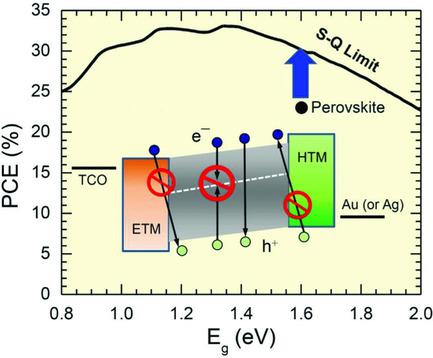当前位置:
X-MOL 学术
›
Adv. Mater.
›
论文详情
Our official English website, www.x-mol.net, welcomes your feedback! (Note: you will need to create a separate account there.)
Causes and Solutions of Recombination in Perovskite Solar Cells.
Advanced Materials ( IF 29.4 ) Pub Date : 2018-09-17 , DOI: 10.1002/adma.201803019 Jiangzhao Chen 1 , Nam-Gyu Park 1
Advanced Materials ( IF 29.4 ) Pub Date : 2018-09-17 , DOI: 10.1002/adma.201803019 Jiangzhao Chen 1 , Nam-Gyu Park 1
Affiliation

|
Organic-inorganic hybrid perovskite materials are receiving increasing attention and becoming star materials on account of their unique and intriguing optical and electrical properties, such as high molar extinction coefficient, wide absorption spectrum, low excitonic binding energy, ambipolar carrier transport property, long carrier diffusion length, and high defects tolerance. Although a high power conversion efficiency (PCE) of up to 22.7% is certified for perovskite solar cells (PSCs), it is still far from the theoretical Shockley-Queisser limit efficiency (30.5%). Obviously, trap-assisted nonradiative (also called Shockley-Read-Hall, SRH) recombination in perovskite films and interface recombination should be mainly responsible for the above efficiency distance. Here, recent research advancements in suppressing bulk SRH recombination and interface recombination are systematically investigated. For reducing SRH recombination in the films, engineering perovskite composition, additives, dimensionality, grain orientation, nonstoichiometric approach, precursor solution, and post-treatment are explored. The focus herein is on the recombination at perovskite/electron-transporting material and perovskite/hole-transporting material interfaces in normal or inverted PSCs. Strategies for suppressing bulk and interface recombination are described. Additionally, the effect of trap-assisted nonradiative recombination on hysteresis and stability of PSCs is discussed. Finally, possible solutions and reasonable prospects for suppressing recombination losses are presented.
中文翻译:

钙钛矿太阳能电池复合的原因和解决方案。
有机-无机杂化钙钛矿材料因其独特且引人入胜的光学和电学性质而受到越来越多的关注,并成为明星材料,例如高摩尔消光系数,宽吸收光谱,低激子结合能,双极性载流子传输特性,长载流子扩散长度长,缺陷容忍度高。尽管钙钛矿型太阳能电池(PSC)的最高功率转换效率(PCE)达到22.7%,但与理论的Shockley-Queisser极限效率(30.5%)仍然相去甚远。显然,钙钛矿薄膜中陷阱辅助的非辐射(也称为Shockley-Read-Hall,SRH)重组和界面重组应主要负责上述效率距离。这里,系统地研究了抑制本体SRH重组和界面重组的最新研究进展。为了减少薄膜中的SRH重组,研究了工程钙钛矿的成分,添加剂,尺寸,晶粒取向,非化学计量方法,前体溶液和后处理。本文的重点是在正常或倒置的PSC中钙钛矿/电子传输材料和钙钛矿/空穴传输材料界面处的复合。描述了抑制本体和界面重组的策略。此外,讨论了陷阱辅助非辐射重组对PSC滞后和稳定性的影响。最后,提出了抑制重组损失的可能解决方案和合理的前景。为了减少薄膜中的SRH重组,研究了工程钙钛矿的成分,添加剂,尺寸,晶粒取向,非化学计量方法,前体溶液和后处理。本文的重点是在正常或倒置的PSC中钙钛矿/电子传输材料和钙钛矿/空穴传输材料界面处的复合。描述了抑制本体和界面重组的策略。此外,讨论了陷阱辅助非辐射重组对PSC滞后和稳定性的影响。最后,提出了抑制重组损失的可能解决方案和合理的前景。为了减少薄膜中的SRH重组,研究了工程钙钛矿的成分,添加剂,尺寸,晶粒取向,非化学计量方法,前体溶液和后处理。本文的重点是在正常或倒置的PSC中钙钛矿/电子传输材料和钙钛矿/空穴传输材料界面处的复合。描述了抑制本体和界面重组的策略。此外,讨论了陷阱辅助非辐射重组对PSC滞后和稳定性的影响。最后,提出了抑制重组损失的可能解决方案和合理的前景。和后处理进行了探讨。本文的重点是在正常或倒置的PSC中钙钛矿/电子传输材料和钙钛矿/空穴传输材料界面处的复合。描述了抑制本体和界面重组的策略。此外,讨论了陷阱辅助非辐射重组对PSC滞后和稳定性的影响。最后,提出了抑制重组损失的可能解决方案和合理的前景。和后处理进行了探讨。本文的重点是在正常或倒置的PSC中钙钛矿/电子传输材料和钙钛矿/空穴传输材料界面处的复合。描述了抑制本体和界面重组的策略。此外,讨论了陷阱辅助非辐射重组对PSC滞后和稳定性的影响。最后,提出了抑制重组损失的可能解决方案和合理的前景。讨论了陷阱辅助非辐射复合对PSCs滞后和稳定性的影响。最后,提出了抑制重组损失的可能解决方案和合理的前景。讨论了陷阱辅助非辐射复合对PSCs滞后和稳定性的影响。最后,提出了抑制重组损失的可能解决方案和合理的前景。
更新日期:2019-11-20
中文翻译:

钙钛矿太阳能电池复合的原因和解决方案。
有机-无机杂化钙钛矿材料因其独特且引人入胜的光学和电学性质而受到越来越多的关注,并成为明星材料,例如高摩尔消光系数,宽吸收光谱,低激子结合能,双极性载流子传输特性,长载流子扩散长度长,缺陷容忍度高。尽管钙钛矿型太阳能电池(PSC)的最高功率转换效率(PCE)达到22.7%,但与理论的Shockley-Queisser极限效率(30.5%)仍然相去甚远。显然,钙钛矿薄膜中陷阱辅助的非辐射(也称为Shockley-Read-Hall,SRH)重组和界面重组应主要负责上述效率距离。这里,系统地研究了抑制本体SRH重组和界面重组的最新研究进展。为了减少薄膜中的SRH重组,研究了工程钙钛矿的成分,添加剂,尺寸,晶粒取向,非化学计量方法,前体溶液和后处理。本文的重点是在正常或倒置的PSC中钙钛矿/电子传输材料和钙钛矿/空穴传输材料界面处的复合。描述了抑制本体和界面重组的策略。此外,讨论了陷阱辅助非辐射重组对PSC滞后和稳定性的影响。最后,提出了抑制重组损失的可能解决方案和合理的前景。为了减少薄膜中的SRH重组,研究了工程钙钛矿的成分,添加剂,尺寸,晶粒取向,非化学计量方法,前体溶液和后处理。本文的重点是在正常或倒置的PSC中钙钛矿/电子传输材料和钙钛矿/空穴传输材料界面处的复合。描述了抑制本体和界面重组的策略。此外,讨论了陷阱辅助非辐射重组对PSC滞后和稳定性的影响。最后,提出了抑制重组损失的可能解决方案和合理的前景。为了减少薄膜中的SRH重组,研究了工程钙钛矿的成分,添加剂,尺寸,晶粒取向,非化学计量方法,前体溶液和后处理。本文的重点是在正常或倒置的PSC中钙钛矿/电子传输材料和钙钛矿/空穴传输材料界面处的复合。描述了抑制本体和界面重组的策略。此外,讨论了陷阱辅助非辐射重组对PSC滞后和稳定性的影响。最后,提出了抑制重组损失的可能解决方案和合理的前景。和后处理进行了探讨。本文的重点是在正常或倒置的PSC中钙钛矿/电子传输材料和钙钛矿/空穴传输材料界面处的复合。描述了抑制本体和界面重组的策略。此外,讨论了陷阱辅助非辐射重组对PSC滞后和稳定性的影响。最后,提出了抑制重组损失的可能解决方案和合理的前景。和后处理进行了探讨。本文的重点是在正常或倒置的PSC中钙钛矿/电子传输材料和钙钛矿/空穴传输材料界面处的复合。描述了抑制本体和界面重组的策略。此外,讨论了陷阱辅助非辐射重组对PSC滞后和稳定性的影响。最后,提出了抑制重组损失的可能解决方案和合理的前景。讨论了陷阱辅助非辐射复合对PSCs滞后和稳定性的影响。最后,提出了抑制重组损失的可能解决方案和合理的前景。讨论了陷阱辅助非辐射复合对PSCs滞后和稳定性的影响。最后,提出了抑制重组损失的可能解决方案和合理的前景。



























 京公网安备 11010802027423号
京公网安备 11010802027423号